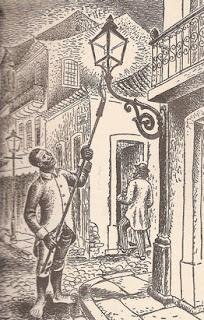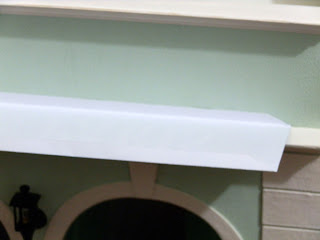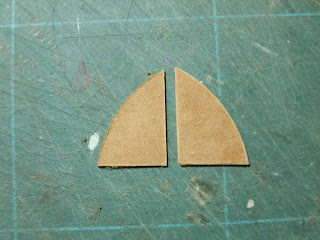OMG!... Is this a mouse hole in my brand new store?... Hope not!!! :)
Você se lembra quando eu trouxe todos os fios das luminárias para um canto no sótão? Bem, agora é hora de realmente conectá-los e fazer a coisa toda funcionar direito...
Do you remember when I "drew" all the lights wires to one corner on the attic? Well, time to actually connect them and make them work..
Para isso vou usar alguns produtos que comprei online na loja Evan's Designs: um transformador de 12 volts - em vez de baterias ou pilhas - e um conector com dois interruptores. Esta loja é minha favorita no que diz respeito a eletrificação. Entregam rápido, têm excelentes preços e são extremamente prestativos para tirar dúvidas!
I'll be using some items I ordered from Evan's Designs: a 12 v transformer - instead of batteries - and a power jack with two switches for this job. They are my favorite suppliers when it comes to wiring & leds. Fast delivery, excellent prices, extremely helpful customer service!
Um interruptor será para as luminárias externas e o outro para as internas.
I'll have one switch for the outside lights and the other one for the lights inside.
Bem, vamos lá então!
So, let's do it!
O primeiro passo é juntar um fio de cada luminária (saem dois de cada uma) e torcê-los bem. Nem precisa usar alicate para isso, são bem maleáveis. Eu aplico um pouco de solda para ter certeza que permanecerão juntos. Ao contrário dos leds, lâmpadas de 12 v não têm polaridade, então tanto faz qual fio será usado onde, basta ter certeza que usou um fio de cada luminária.
First step is to gather one wire from each light fixture (there are two coming from each one) and twist them together. No need to use pliers, they are very malleable. I apply a little bit of soldering to make sure they'll stay together. Unlike LED lights, it doesn't matter which wire you'll attach where, so just make sure you have one of each light in each gathered group.
Aliás, a tarefa de soldar em miniatura fica muito mais fácil se você comprar um ferro de solda de 25W. Qualquer coisa mais poderosa que isso vai esquentar demais os finíssimos fios usados e ficará muito mais quente e complicado para trabalhar. O primeiro ferro que eu usava era do meu irmão e era um de 60W. Não mesmo!
Btw, soldering becomes a lot easier if you get a 25W soldering iron. Anything more powerful than that will heat the tiny little wires too much and it's make things a lot hotter and complicated than needed. The first one I used, used to be my brother's and it's 60W. Nope!
Em segundo lugar, torça a ponta de cada "grupo" de fios com um fio preto de um dos interruptores, e as duas "pernas" restantes de cada grupo ao fio vermelho, que vem do conector. Um pouco de solda de novo, só para ter certeza. Dica: instale o conector no local em que irá ocultá-lo antes de começar esta etapa. Será muito mais difícil posicioná-lo depois disso, pois geralmente é inserido na abertura criada de fora para dentro, para ficar firme e bem encaixado...
Second, twist together one gathering from each "group" of wires to one black wire from the switches, and the remaining "legs" of both groups to the red wire, which goes to the jack. A little bit of soldering again, just to be sure. Tip: install the jack where you want before you start this step. It'll be harder to install it later, as it's usually inserted into the opening from the front, to stay tightly secure...
Em seguida, vire as pontas torcidas/soldadas para um dos lados e proteja-as. Eu esqueci de colocar um pedaço de tubo encolhível (com calor) antes (dãã), então a alternativa foi usar o mesmo esmalte preto que usei nas dobradiças e, depois de seco, enrolei com um pedaço de fita isolante. A solda manterá os fios juntos, mas é importante protegê-los para que não encostem uns nos outros. Isso provocaria um curto-circuito, e você não quer isso, certo? :)
Next, turn the twisted/soldered tips to one side and protect them. I forgot to place a piece of shrinkable tube first (duh!), so the other solution was to use the same black nail polish I used for the door hinges and a little piece of isolating tape after dry. Soldering will keep the wire tips secure together, but you must isolate the tips from each other. You sure do not want them to touch each other by accident and short circuit, right? :)
Agora é hora de esconder tudo a plena vista... :) Eu fiz este "caixa de transporte" com madeira balsa. Nesta foto ainda sem pintura de acabamento. Tem uma grande abertura na parte de baixo (não dá para ver na foto) por onde os fios que saem do "chão" do sótão passam. De novo, faça isso antes de começar a soldar, ou terá um grande problema para resolver!
Now it's time to hide the wires in plain sight... :) I made this shipping crate from balsa wood. Here it's still unpainted or weathered. There is a big opening in the bottom side (not shown in picture) where the wires go through. Again, do this before you start soldering, or you'll be in trouble!
Eis uma vista do interior da "caixa". Os interruptores já foram colados nos lugares. Depois acrescentei umas "travas" para mantê-los firmes. O conector está abaixo deles (seguro com a fita azul):
This is a view from the inside of the "crate". The switches have been glued into their place. I'll later glue some "stops" to secure them there. And the jack is at the bottom (secured with the blue tape):
Esta é a vista da "caixa" sem o tampo falso e sem a parte da frente, e já colada no lugar. Quando quiser ligar as luzes, basta levantar o tampo, deslizar a frente para cima (e retirar) para revelar o conector e os interruptores. Posso repor o tampo, se quiser, enquando as luzes ficam ligadas...
This is the front view of the "crate" without the false top and front, and already glued in place. When I want to turn the lights on, I just remove the top, slide the front up (and out) to reveal the jack & switches. I can replace the top, if I want to, while the lights are on...
Ou posso deixar as luzes apagadas, durante o dia, e tudo fechado e escondido! :)
Or I can leave the lights off, daytime, and everything closed and hidden! :)
 |
| Obrigada! Thank you! |































































